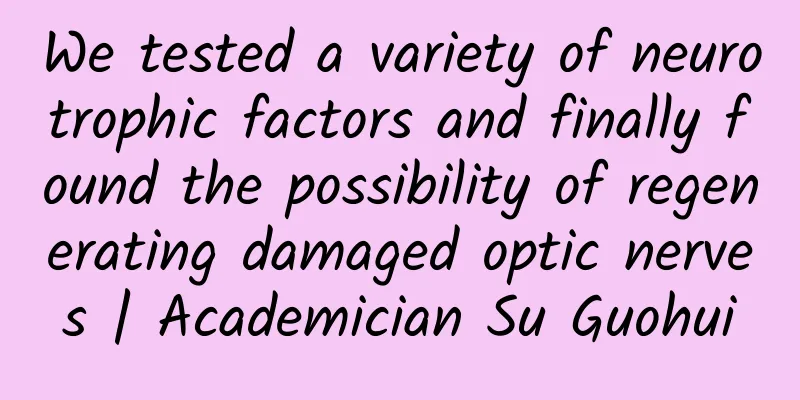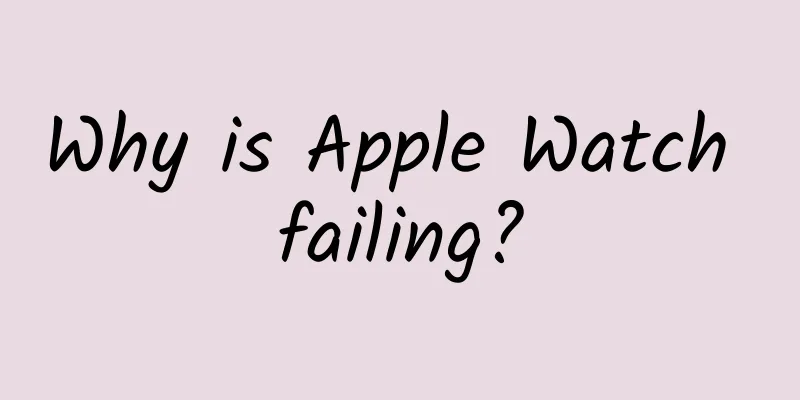We tested a variety of neurotrophic factors and finally found the possibility of regenerating damaged optic nerves | Academician Su Guohui

|
“Every step you take towards your goal will give you a different feeling. This process is very interesting.” ————Su Guohui, Academician of the Chinese Academy of Sciences I am very honored to have this opportunity to meet you online. I am a neuroscientist and have always been very interested in the visual system, especially the protection and regeneration of the optic nerve and retina after damage. Today, let me bring you the latest research in this area. 01/ Curiosity stimulated by “playfulness” Before that, I want to share with you my childhood story. In fact, when I was in primary school, I didn’t study hard and loved playing. Some time ago, an educator’s magazine interviewed me about this. I think playing is very helpful to inspire the curiosity of teenagers. ▲Cover figure of "Educator" magazine I grew up in a relatively traditional family with 2 mothers and 13 brothers and sisters. Can you guess which one is me in the photo below? I am the one sitting in the front center. ▲ Su Guohui in his childhood (middle of the first row on the left) I was very naughty in middle school. For example, you can see from the picture below that I don’t know how I climbed up the tree. Anyway, I liked to do naughty things. Of course, like you, I also had very good friends in middle school. We studied together, played together, etc. ▲Su Guohui in his youth (3rd from left in the right picture) You may be curious about why I am interested in neuroscience? Actually, it was a teacher in my middle school who inspired my interest in this subject. So the influence of teachers on students is very important. This teacher taught biology. In one class, he told us how people see things and how light turns into some specific images in our brains. After listening to him, I became very interested in the visual system. It was because of this teacher that I chose this major in college and graduate school. 02/The complex human brain and nervous system Let me show you a brain. This is a human brain. Our brain is a very wonderful organ. It has countless cells in it. Different areas are responsible for different functions. Now there are still many functions of the brain that have not been figured out. ▲The human brain Look at the picture below. The nervous system is divided into the central nervous system and the peripheral nervous system. The blue one is our central nervous system, which is the brain, spinal cord, and optic nerve. The yellow one is the peripheral nervous system. What is the difference between the two? ▲Distribution of the human nervous system They all have different functions. Peripheral nerves are easier to regenerate after injury, but the central nervous system is different. For example, brain injury, spinal cord injury, and optic nerve injury are all very troublesome. So I am very concerned about central nervous system regeneration, especially how to protect the optic nerve after injury and how to make it regenerate. ▲Different areas of the brain From the picture above, we can see that there are different areas in the brain. Some are responsible for our vision, some are responsible for our hearing, some are responsible for movement, etc. We know that there are countless nerve cells in the brain. Look at the picture below. This nerve cell is actually very amazing. Each nerve cell is composed of several parts, a cell body, and dendrites. The dendrites are called dendritic spines. Why is this place important? This is where nerve cells communicate with other nerve cells. ▲Basic nerve cell structure In fact, there are many types of nerve cells. Let me first introduce to you several more important cells, namely sensory neurons, relay neurons and motor neurons. These cells play different functions in our brain. ▲3 main types of nerve cells But in addition to nerve cells, there is another type of cell in our brain, which is the glial cell. Unlike nerve cells, it does not have the ability to generate electricity, but it has the function of division. For example, from the picture below we can see that there are many types of glial cells. ▲ Glial cell classification Oligodendrocytes are responsible for myelinating axons in the central nervous system, which allows electricity to be transmitted quickly. In addition, glial cells can divide, so some people who unfortunately have tumors in their brains are all gliomas, not neuroblastomas. The effects of central nervous system injury and peripheral nervous system injury are different. Central nervous system regeneration is more difficult, while peripheral nervous system can regenerate rapidly because myelin is a cell. However, in central nervous system cells, the fibers are small dendrites, which not only do not provide neurotrophic factors for regeneration, but also have some inhibitory factors. Therefore, neuroscientists are very concerned about how to study how to help these central nervous system regenerate, including our optic nerve. 03/Structure and characteristics of the optic nerve Look at the picture below. You can see that there are two eyes under the brain, and the eyes are connected to nerves, which are different targets in the brain. ▲Vision system The retina is actually part of the central nervous system, and its regeneration ability is very low, so we need to find ways to protect it and restore it after it is really damaged. There are relatively few types of cells in the retina, about 5 types, namely photoreceptors, horizontal cells, bipolar cells, amacrine cells and ganglion cells. ▲Five types of neurons in the retina Of course, the ganglion cells, their fibers form the optic nerve, but there are more than 30 types of ganglion cells. You may ask what is the function of vision? Yes, it helps us see things, but the optic nerve is connected to different parts of the brain, such as the superior colliculus, which is involved in the control of the rapid vertical and horizontal movement of the eyeball by the extraocular muscle movement center of the cerebral cortex. In simple terms, if something moves near you, the superior colliculus will help your eyeball turn over. In addition, the lateral geniculate body is connected to the visual cortex. For example, I can see where everyone is sitting and what they are wearing, all thanks to the lateral geniculate body and the cerebral cortex. There is also the pupil reflex. When we see strong light, our pupil will contract. This is related to the function of the optic nerve. Finally, there is the suprachiasmatic nucleus, which helps us understand whether it is day or night. ▲Main visual target organs Let's look at the picture below. After the peripheral nerves are damaged, the blue ones can regenerate because the myelin cells are microglia, which can promote nerve regeneration, but it is difficult for the central nervous system. ▲Schematic diagram of nerve regeneration after injury Why does the optic nerve lack the ability to regenerate? Now this can be divided into two parts, the first is external factors, and the second is internal factors. The external factors are the lack of nutritional factors or molecules that promote axon growth, and the presence of molecules that hinder axon growth; the internal factors are that the axon regeneration potential of neurons is low, that is, when neurons are adults, their regeneration ability gradually decreases. How to make the optic nerve regenerate? I would like to share a few concepts with you. First, we need to protect the retinal ganglion cells so that they will not die after being damaged. If they die, the optic nerve will also be gone. Second, we need to allow the optic nerve to regenerate in a good environment. Third, we need to make sure that it has a good connection with the target area, as shown in the figure. Fourth, we need to hope that its function will be restored after it is connected, so that regeneration will be meaningful. ▲ Steps of axon regeneration in retinal ganglion cells Neuroprotection is shown in the figure below. Many different methods have been used in the past. Next, I would like to share with you the work I have done in this area. ▲Detailed explanation of retinal ganglion cell axon regeneration 04/Preliminary trial of optic nerve regeneration in collaboration with international experts You see this scientist, his name is Aguayo, he is a very famous Canadian scientist. In 1985, when I was a teacher at the University of Hong Kong, I was particularly interested in his work because he proposed a concept that if we can change the environment of the central nervous system, we can regenerate the central nervous system. ▲Prof. Aguayo His initial experiments were on the spinal cord, and they also wanted to try the optic nerve, but they were never successful. I was very curious, why did he fail? I met him at a meeting one time, and I said, "Aguayo, I work on visual systems, and I'd love to work with you. Of course, if I want to do this experiment, I need to learn the technology first." He said, "Sure, no problem." Then I really went there. I still remember it very clearly. The first day I went there was just Chinese New Year’s Eve. I don’t know if you have been to this place. It was very cold in winter, about minus 40 degrees Celsius, and it was snowing. I finally understood Aguayo. He said you are welcome to come, but come in the winter. You can't do anything else but work. I stayed there for 6 months just to learn his technology. Later, as a scientist, I thought: Why can't he do it? It turned out that he used a wrong method. He mainly replaced the optic nerve with the peripheral nerve, but he put it in the wrong position, too far away. So I suggested putting the peripheral nerve inside the eyeball, and sure enough, we saw the result that day. Please look at the mouse in the lower left corner. I took out the peripheral nerve from its leg and put it into the animal's eyeball, probably next to the retina, so the peripheral nerve is very close to the damaged fibers. ▲ Visual repair mouse experiment So & Aguayo, 1985 Brain Res (Citation: 460) In the upper right picture you can see a lot of cells. Neuroscientists use a marking method to mark the fibers and cell bodies that regenerate into peripheral nerves. When we saw the result that day, the whole lab was very happy, and we took the specimens to discuss it for about an hour. Then I remembered that I had asked my wife to wait for me at a place that night. We had planned to go to the opera together, but later I had no choice but to go there and explain it to her. This incident left a deep impression on me. So when scientists are doing research, they often enter a state of selflessness and forget many other things. Our research shows that the optic nerve can regenerate as long as we change its microenvironment. After this discovery, I returned to the University of Hong Kong to continue to follow up on this research. The picture below explains why Aguayo's laboratory was unable to regenerate the optic nerve before. This is because he placed the peripheral nerves too far away from the eyeball. Because they were placed too far away, the regenerative ability was greatly reduced. ▲Regeneration experiment of retinal ganglion cell axons in adult hamsters Later, I also worked with Professor Cui Qi to study these regenerations. Now that we know that it can regenerate on peripheral nerves, we hope to find out what neurotrophic factor it is related to. So we did several neurotrophic factor experiments, such as NT3, BDNF, CNTF, etc. The final experimental results are shown in the figure below. We found that CNTF, which stands for ciliary neurotrophic factor in English, has the best effect. ▲Multiple neurotrophic factor effect tests ▲Ciliary neurotrophic factor after optic nerve intraorbital segment resection and bridging peripheral nerves In addition, as you can see from the picture above, the time when the number of regenerative cells is the highest is when we give the highest amount of CNTF. So we have proved two points during this period. The first is that as long as we improve the microenvironment of the optic nerve, it can regenerate. At the same time, we can also inject some neurotrophic factors and CNTF into the eyeball. These substances can greatly enhance the ability of the optic nerve to regenerate. After this study was completed, it was like opening a new situation. Many different laboratories around the world were very interested in this. They used different methods to confirm whether optic nerve regeneration was really like this, and their research also confirmed that it was indeed the case. For example, they used genetic modification or injection of different neurotrophic factors, etc. They paid special attention to improving the internal environment. However, the relevant research was done on animals, and these methods are difficult to transfer to humans. I will not elaborate on the various reasons. I am still more concerned about whether the research results can be applied to humans in the end. 05/New research and development results that promote the reconstruction of the visual system So I recently worked with Professor Li Xiaoguang of Beijing Capital Medical University to use his very innovative method. What is this method like? I just mentioned that CNTF can promote nerve regeneration, but I can only inject it once or twice. Professor Li Xiaoguang's method can put CNTF in through a material, and it can be released slowly, which works. In addition, his material is very safe. So we worked together on this project, and the effect is really very good. Our experiment used this method to completely cut the optic nerve of adult rats, and then put a tube into it, which contained CNTF and chitosan, and then tracked it to see if its function was restored, and to see if it could finally be reshaped. So our results show that CNTF and chitosan can promote the reconstruction of the visual system of adult mammals, emphasizing that it is possible to repair the optic nerve after severe damage. In this regard, our current technology is very safe. ▲Member of the R&D team of ciliary neurotrophic factor-chitosan The picture above shows members of our R&D team. The one in the middle is Professor Li Xiaoguang, and Dr. Liu. We completed this work together. ▲Characteristics of ciliary neurotrophic factor-chitosan Let me introduce this work to you. First, let's take a look at the picture above. This is the material we use. Chitosan is non-toxic and degradable, so it is very safe. How long can it be released slowly? It can be released for 12 weeks, which is very long. I used to inject CNTF into the eyeball only once or twice, but this is equivalent to having CNTF in the eyeball for a long time, which can also help promote optic nerve regeneration. As you can see in the diagram below, we remove the two millimeters in the middle of the optic nerve, and then put the tube in, which contains chitosan and CNTF. ▲Optic nerve rupture and bioactive material implantation This experiment is very important because you want to make sure that there are no residual fibers in the entire cut part. Many previous studies have always been unable to rule out the possibility of crushing, so our experimental results completely solved this problem. We let the animals survive for 7 weeks and then studied their histology and function. One of them is called CTB, which can track the path of regenerated fibers. We have many targets in the brain, such as the superior colliculus, lateral geniculate body, suprachiasmatic nucleus, etc. Let me show you these results. ▲Ganglion cell axons regenerate to vision-related areas in the brain From the above picture, we can see that the optic nerve regeneration is the suprachiasmatic nucleus. The red color represents that we use CTB to track the optic nerve and see that it is related to these targets. In addition, we also see the olivary nucleus in the anterior tectum, which is the function of the pupil. We found that it is connected, and then look at the lateral geniculate body. There are many red things, indicating that it is also related to this. ▲Ganglion cell axons regenerate to the visual-related area of the brain (superior colliculus) Next is the superior colliculus, which obviously has many connections. This is obviously a very convincing study. Of course, the most important thing in this study is whether it has synapses, so we use electron microscopy to track it. The following are all the results of electron microscopy. We can clearly see that it not only regenerates there, but also connects. ▲Re-establishment of lateral geniculate body synapses Of course, we need to see if it has this function in the end. We did several tests and the results are as follows. First, we looked at the pupil reflection. Sure enough, the regeneration is useful. The CNTF using this material is useful. If it is not useful, it is invisible. ▲Recovery of visual function From the diagram below, we can see that mice like to run to dark places, which is indeed the case. ▲Recovery of visual function In addition, we noticed that there is a concept called "visual cliff". What is the visual cliff? We dare not go out when we see a high place, but how can we see the high place? The mouse can see the visual cliff after nerve regeneration, which means that it has this function. So to summarize our research in this regard: first, it promoted the long-distance regeneration of retinal ganglion cell axons; second, it promoted the formation of myelin sheaths of newly formed axons of retinal ganglion cells; third, it protected retinal ganglion cells, including connecting axons, and most importantly, restored function. ▲The role of CNTF-chitosan So in general, our study of the optic nerve is related to light, which we use to see things, so the connection between the optic nerve and the brain is very important. In addition, our visual system also has a non-image function, such as when I look at certain things, some are happy, and some are unhappy. We will continue to study this next. ▲Research field: Non-imaging functions of light What breakthroughs and innovations are there in this research? We use a technology that can be transferred to humans to conduct this research. The next step is to conduct experiments on monkeys, and then it will be applied to humans soon. 06/Some advice for teenagers Finally, I would like to share with you some advice I have for young people. As a young person, it is very important for you to have a goal, because only with a goal can you control your destiny. Maybe everyone's future is different. Some students hope to be a doctor, a musician, an engineer, or a scientist in the future. I think being a scientist is very good. Why? Because as a scientist, you can do different things every day and every period of time, and you do what you like. The government also supports you with funds. At the same time, you have friends all over the world because many scientists will do things related to you. After you have a goal, you must be proactive. Another important point is to keep improving yourself. “Keep improving yourself” is actually the four words in the Qian Gua in the Book of Changes. These four words have a great influence on me, so I give them to you. I hope you will motivate yourself to keep improving yourself and do better every day. In addition, I hope that everyone will not underestimate the training of some basic skills. You should learn a lot of different things in school. In the process of achieving your goals, you will have different feelings at every step, and this process is very interesting. In addition, you can also have a new goal after achieving a certain goal. I also strongly encourage students to have a win-win mentality, to benefit themselves and others. Because you need help from different people to survive in this society. At home, your family helps you, at school, your classmates help you, and after you enter society, your friends are also very important to you. So you should not only consider your own interests, but also the interests of others. This is called "win-win thinking." Why do I advocate "asking for trouble"? When I was an undergraduate, I worked in a place, and I would take the initiative to find things that were not my job to do. Others would think that you are willing to help, and they would help you in the future. This is the cause and effect relationship in Buddhism. I think it will be very useful for your future growth. So now that you are studying in middle school, you should also make good use of the different environment of middle school. Our brain is like a sponge. You are so lucky to study in such a good school. You should learn many different things well. Another thing is that your life goals will actually improve and sublimate with your experiences. When I was studying at MIT in the United States, I really wanted to be a scientist. I wondered how I could learn better. I read a lot of biographies of scientists, one a week, and after seven or eight weeks, I already knew how several scientists did what they did. This is not just for scientists. If you want to be a doctor or engineer, you can also consider this method. ▲ Spanish scientist and Nobel Prize winner Cajal The person above is Cajal, whom I respect very much. He is Spanish, won the Nobel Prize, and is very patriotic. I found that these scientists have no national boundaries, but they have one thing in common, that is, they all love their own country very much. Finally, I would like to give you some advice. For example, in addition to studying actively, you must also stay active, exercise every day, consider some mental issues, do important things first, and be trustworthy. These are very important for your future development. To summarize, I hope that you can all pursue your goals, be proactive, strive for self-improvement, and have a sense of family and country. You see, our country provides us with such a good learning environment. Since you are the future of the country, I hope you can learn more in this area and serve the country more. We also need to have a win-win mentality, benefit ourselves and others, stay energetic, increase our value, be optimistic and positive, etc. Thank you everyone. - END - The articles and speeches only represent the author’s views and do not represent the position of Wanxiangyue. |
>>: The more you eat, the whiter your skin becomes?! The truth is...
Recommend
The 8 most meaningless code comments
Over the years, I've had the great pleasure o...
Planning an event? Using node-based architecture
What is the node-based architecture of activities...
The Sexy and Skinny of Operator TVs from Damai TV
Nowadays, the word "disruption" has bec...
Dongfeng Honda recalls more than 80,000 vehicles due to minor problems with electric rearview mirrors
Automobile recalls due to quality issues are beco...
User operations in Internet finance: How to promote high orders and high conversions?
I. Four Behavioral Characteristics of Internet Fi...
Get rid of the 80% of miscellaneous jobs and move into the 20% of senior operations
Internet jobs are usually divided into three cate...
SEM One Hundred Thousand Whys? What does sem do?
Baidu's paid ranking is based on Baidu's ...
She is rooted in isotope geochemistry and is determined to explore habitable planets outside the earth!
In the vast universe, various elements are consta...
Haolong and Qingzhou will be added to the fleet! What other surprises will China's space program bring in 2025?
In 2025, China's manned spaceflight journey i...
Ruipu Lanjun released a series of big moves at the IAA! The Wending family products, European development strategy, and ESG carbon neutrality route were all launched
The full matrix Wending family series of products...
Is it difficult to activate new users? Learn these 6 tips to improve user retention!
User activation is the first step after acquiring...
Small Demo, Big Knowledge - Learn Android Coordinates by Controlling Button Movement
Today I will share a simple demo. The function im...
Internet celebrity fox died in the snow? Stop feeding wild animals!
On December 26, the topic "Internet celebrit...
What is the purpose of following hot topics and taking advantage of trends every day?
Now when it comes to chasing hot topics and lever...
The barbaric P2P online lending has seen the dawn of civilization
For the P2P industry, the impact of policies has ...


![[Recommended by Zhihu] Those Android development tools that you can’t stop using](/upload/images/67ebe8a2e11b5.webp)






